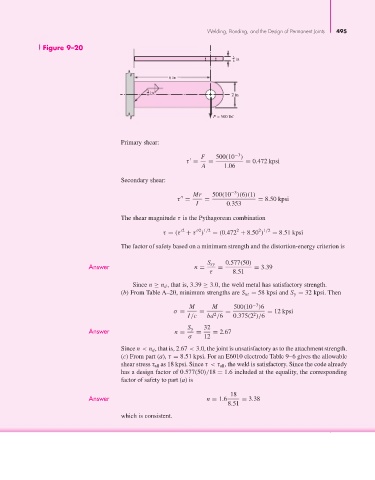Page 521 - Shigley's Mechanical Engineering Design
P. 521
bud29281_ch09_475-516.qxd 12/16/2009 7:13 pm Page 495 pinnacle 203:MHDQ196:bud29281:0073529281:bud29281_pagefiles:
Welding, Bonding, and the Design of Permanent Joints 495
Figure 9–20
3 in
8
6 in
3 in
8 2 in
F = 500 lbf
Primary shear:
−3
F 500(10 )
= 0.472 kpsi
τ = =
A 1.06
Secondary shear:
−3
Mr 500(10 )(6)(1)
= 8.50 kpsi
τ = =
I 0.353
The shear magnitude τ is the Pythagorean combination
2 2 1/2 2 2 1/2
τ = (τ + τ ) = (0.472 + 8.50 ) = 8.51 kpsi
The factor of safety based on a minimum strength and the distortion-energy criterion is
Answer n = S sy = 0.577(50) = 3.39
τ 8.51
Since n ≥ n d , that is, 3.39 ≥ 3.0, the weld metal has satisfactory strength.
(b) From Table A–20, minimum strengths are S ut = 58 kpsi and S y = 32 kpsi. Then
−3
M M 500(10 )6
σ = = 2 = 2 = 12 kpsi
I/c bd /6 0.375(2 )/6
32
S y
Answer n = = = 2.67
σ 12
Since n < n d , that is, 2.67 < 3.0, the joint is unsatisfactory as to the attachment strength.
(c) From part (a), τ = 8.51 kpsi. For an E6010 electrode Table 9–6 gives the allowable
shear stress τ all as 18 kpsi. Since τ< τ all, the weld is satisfactory. Since the code already
has a design factor of 0.577(50)/18 = 1.6 included at the equality, the corresponding
factor of safety to part (a)is
18
Answer n = 1.6 = 3.38
8.51
which is consistent.

